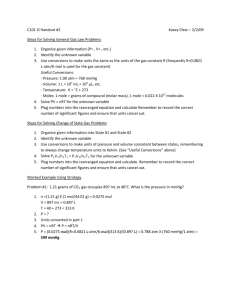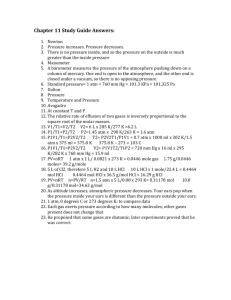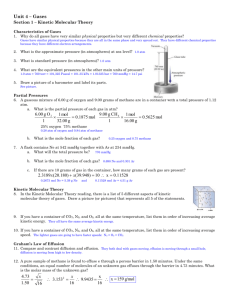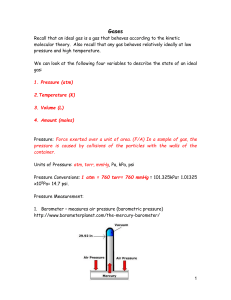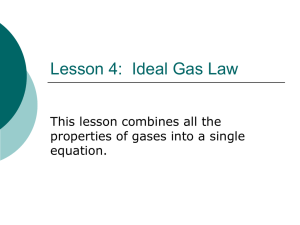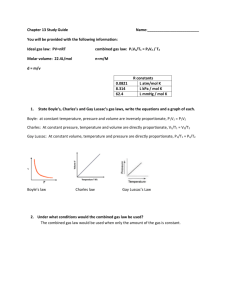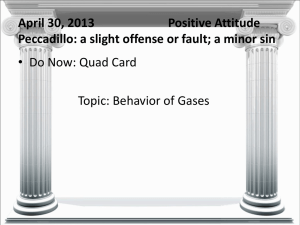V - Dr KHALID SHADID
advertisement
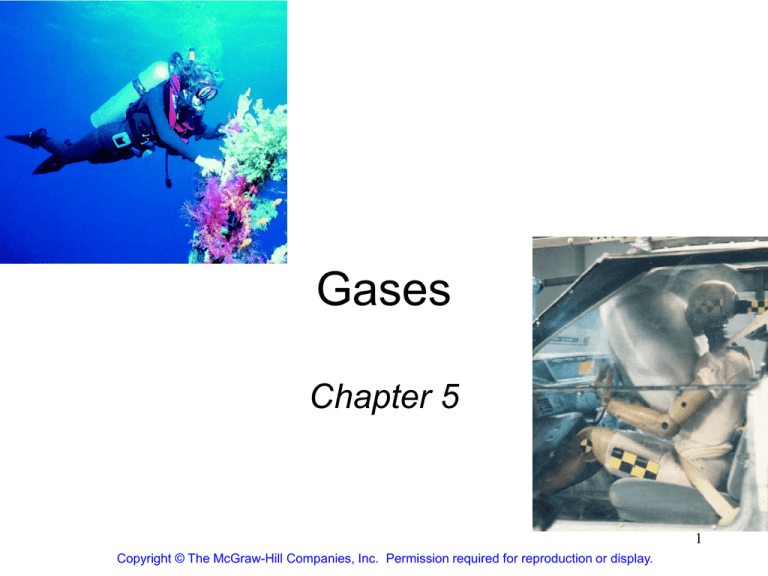
Gases Chapter 5 1 Copyright © The McGraw-Hill Companies, Inc. Permission required for reproduction or display. Characteristics of Gases • Gases expand to fill any container. – random motion, no attraction • Gases are fluids (like liquids). – no attraction • Gases have very low densities. – no volume = lots of empty space 2 Characteristics of Gases • Gases can be compressed. – no volume = lots of empty space • Gases undergo diffusion & effusion. – random motion 3 11 of the periodical table elements are in the gas form. Pressure = Force Area Torrcelli (force = mass x acceleration) Units of Pressure 1 torr = 1 mmHg 1 atm = 760 mmHg = 760 torr 1 atm = 1.01325 x 105 Pa = 101,325 kPa 5 10 miles 4 miles Sea level 0.2 atm 0.5 atm 1 atm 6 • The atmospheric pressure at the summit of Mt. McKinley (Denali) is 606 mm Hg on a certain day. What is the pressure in atmospheres? Boyle’s Law Volume is inversely proportional to pressure P a 1/V P x V = constant P1 x V1 = P2 x V2 Constant temperature Constant amount of gas 8 A sample of chlorine gas occupies a volume of 946 mL at a pressure of 726 mmHg. What is the pressure of the gas (in mmHg) if the volume is reduced at constant temperature to 154 mL? P x V = constant P1 x V1 = P2 x V2 P2 = P1 = 726 mmHg P2 = ? V1 = 946 mL V2 = 154 mL P1 x V1 V2 726 mmHg x 946 mL = = 4460 mmHg 154 mL 9 Charles’ Law Volume is proportional to temperature Variation in Gas Volume with Temperature at Constant Pressure As T increases V increases 11 Gay-Lussac’s Law Temperature is proportional to pressure Variation of Gas Volume with Temperature at Constant Pressure VaT V = constant x T V1/T1 = V2 /T2 Charles’ & Gay-Lussac’s Law Temperature must be in Kelvin 13 A sample of carbon monoxide gas occupies 3.20 L at 125 0C. At what temperature will the gas occupy a volume of 1.54 L if the pressure remains constant? V1 /T1 = V2 /T2 V1 = 3.20 L V2 = 1.54 L T1 = 398.15 K T2 = ? T1 = 125 (0C) + 273.15 (K) = 398.15 K T2 = V2 x T1 V1 = 1.54 L x 398.15 K 3.20 L = 192 K 14 Avogadro’s Law V a number of moles (n) Constant temperature Constant pressure V = constant x n V1 / n1 = V2 / n2 15 The Gas Laws • Boyles Law pressure -- volume – P 1/V • Charles Law temperature -- volume – VT • Avogadros Law moles -- volume – Vn • Gay Lussac Law – PT temperature -- pressure Ammonia burns in oxygen to form nitric oxide (NO) and water vapor. How many volumes of NO are obtained from one volume of ammonia at the same temperature and pressure? 4NH3 + 5O2 1 mole NH3 4NO + 6H2O 1 mole NO At constant T and P 1 volume NH3 1 volume NO 17 Ideal Gas Equation Boyle’s law: P a 1 (at constant n and T) V Charles’ law: V a T (at constant n and P) Avogadro’s law: V a n (at constant P and T) Va nT P V = constant x nT P =R nT P R is the gas constant PV = nRT 18 The conditions 0 0C and 1 atm are called standard temperature and pressure (STP). For any Gas Experiments show that at STP, 1 mole of an ideal gas occupies 22.414 L. PV = nRT (1 atm)(22.414L) PV R= = nT (1 mol)(273.15 K) R = 0.082057 L • atm / (mol • K) 19 What is the volume (in milliliters) occupied by 63.7 g of HCl at STP? T = 0 0C = 273.15 K P = 1 atm PV = nRT nRT V= P 1 mol HCl n = 63.7 g x = 1.75 mol 36.45 g HCl 1.75 mol x 0.0821 V= L•atm mol•K x 273.15 K 1 atm V = 39.1 L = 391 ml 20 What is the volume (in liters) occupied by 49.8 g of HCl at STP? T = 0 0C = 273.15 K P = 1 atm PV = nRT nRT V= P 1 mol HCl n = 49.8 g x = 1.37 mol 36.45 g HCl 1.37 mol x 0.0821 V= L•atm mol•K x 273.15 K 1 atm V = 30.7 L 21

